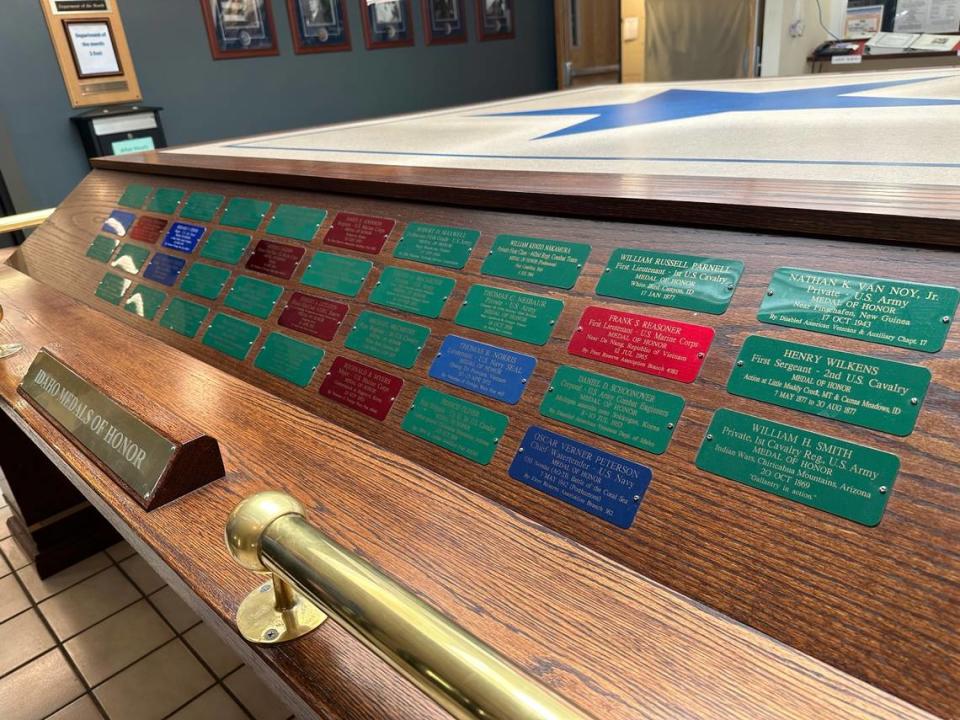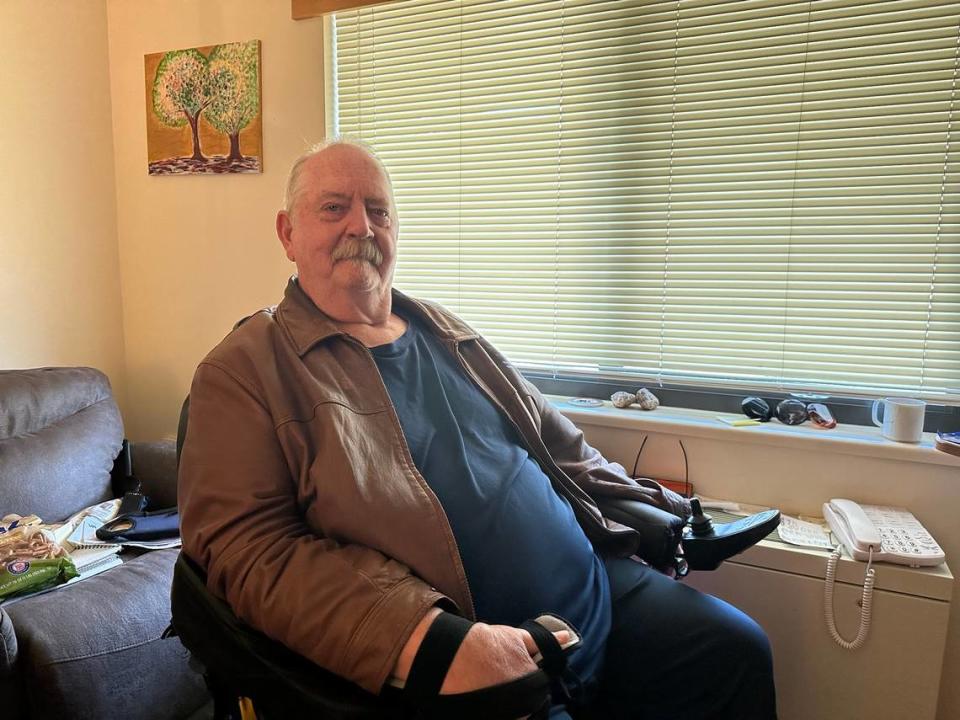How federal bureaucracy is killing new veterans home in Boise | Opinion
Roger Byrd’s entire world is confined to an 8-by-12-foot space in his half of a room at the Idaho State Veterans Home in Boise.
His only wall for privacy is a hospital curtain drawn between him and his roommate. He shares a bathroom with three other residents.
But you won’t catch the Vietnam veteran complaining.
“It’s not bad,” Byrd told me in an interview in his room Monday morning. “I like it here. They always give you whatever you need.”
So grateful he is for the staff, Byrd keeps a couple of shelves devoted to candy bars, gum and other snacks available for them to show his appreciation.
“The only thing is you got a roommate and a bathroom for four people,” the former Air Force jet mechanic said. “It’d be nice to get that new building.”
That new building he’s talking about is a new Veterans Home that’s been in the works since 2019, when funding for it was first requested. Plans call for a new building at the site of the existing 60-year-old facility, 320 Collins Road, in Boise.
After Boise’s grant was approved in 2019, the project was put on a priority list but missed the cut for final funding for four straight years. Then last year, finally, funding for the project got the green light. Crews were scheduled to break ground next month.
The victory didn’t last long, though.

Veterans home funding withdrawn
In January, Veterans Affairs officials informed Idaho that the project needed to meet newly adopted criteria under the recently passed Build America Buy America Act.
The act, passed by Congress in 2022, stipulates that any construction project funded by federal dollars must exclusively use domestically sourced materials, a requirement that has proved unfeasible due to the current limitations of American manufacturing.
“It’s a great law, and it’s a great idea,” Mark Tschampl, director of the Idaho Division of Veterans Services, told me in a phone interview. “The problem is American manufacturing hasn’t caught up to it yet, nor have they provided enough incentives to American manufacturing for them to jump on board with that.”
Idaho officials had a deadline of Feb. 26 to meet the criteria, but there was no way that was possible, and in March, local officials were informed that the VA withdrew funding for the project because it didn’t meet the BABAA requirements.
Tschampl said some examples of items they’re not able to source domestically include various HVAC and electrical components; electrical circuit breakers, including switchgear, distribution gear, panel boards and switchboard components; LED-compatible lighting; elevator units; non-ferrous metals for screws, fasteners and bolts for drywall, framing, and roofing; and steel coil material.
The act included provisions for waivers in cases of non-availability or excessive cost, which the Boise Veterans Home clearly qualified for, but the VA has taken a hard-line stance, refusing to grant waivers to states like Idaho.
VA’s policy is to not provide waivers of BABAA requirements for entire infrastructure projects, including state home construction projects, and VA has communicated this to all states, according to Terrence Hayes, press secretary for the Department of Veterans Affairs.
“VA is fully committed to supporting state veterans homes that provide aging veterans with care that is tailored to their needs,” Hayes wrote in an emailed statement to me. “Our priority at VA is to work with states to help ensure that all projects are compliant with the Buy America Build America Act (BABAA) so they can receive VA funding.”
But this hard-line stance on no waivers is frustrating for Idaho officials.
The act itself includes waivers. One waiver is based on whether compliance with BABAA would increase costs by more than 25%. Tschampl said their contractors estimated costs would increase by $30 million, or 28%, but Idaho was still denied.
One can’t help but feel for the veterans caught in the crossfire, those who have served their country and now find themselves at the mercy of bureaucratic inertia.
“I think it’s stupid,” resident Rene “Skip” Nadeau told me in an interview in his room, speaking of the bureaucratic delay for the new building. “The plans were already put in place. If it was already approved, bend the rules a little bit and make this thing happen.”

Plans for new veterans home
Plans for the new building include private rooms and private bathrooms for every resident, larger spaces for activities and amenities, a larger chapel, a movie theater, a sports bar and smaller, personalized dining areas in the residential areas.
“That’s really part of the goal is to create much more of a home-like atmosphere for the residents,” Rick Holloway, the Veterans Home administrator, said in an interview.
As Tschampl noted, it’s not just about buildings; it’s about the quality of care provided to those who have sacrificed for their country. The inability to proceed with these construction projects means veterans are left in outdated facilities, lacking the privacy and safety they deserve.
“It’s not just about compliance with laws,” Tschampl said. “It’s about fulfilling our moral obligation to those who have served.”
The Veterans Home building was built in 1965. It’s in remarkably good condition, but Tschampl said maintenance of the old building is becoming more expensive.
Holloway, who’s been the home’s administrator since 2016, gets emotional when he thinks of another reason for the upgrade.
He remembers the date exactly: Oct. 17, 2020. It was a Saturday, and the Idaho Veterans Home had its first outbreak of COVID-19.
By the time the outbreak was over, 11 residents had died within three weeks.
“Let me tell you what it’s like to see these residents, healthy one week, and then three weeks later gasping for breath and dying,” Holloway said. “We did everything we could do. But with two beds to a room and one shared bathroom for four people, there’s only so much we could do. We shouldn’t have to go through that again.”
Construction costs escalate
Here’s the other maddening, Kafkaesque part about this process. It’s been five years since the new building was first proposed in 2019, at a cost of about $120 million.
It would have increased capacity to 156 beds on five floors from the current 122 beds on two floors.
In the amount of time that the project has been waiting and gone through bureaucratic hoops, the cost of that 156-bed, five-story building escalated to $170 million. But Idaho had to stay within the original cost of $120 million, so state officials had to make cuts and scale the plans down to four stories and 122 beds.
The replacement home would still be larger — 153,000 square feet, compared with the existing 100,237 — but it would not increase capacity, in a state that’s one of the fastest-growing in the nation.
Holloway said there’s usually a waiting list for a room, anywhere from just a few to as many as 20 waiting for a spot.
To make matters worse, in preparation for construction and demolition of the existing building, Idaho officials began work on vacating the entire east wing, reducing overall bed capacity to 80 beds.
The cost of the project is about $120 million, and the VA would pick up 65% of the cost, or $77 million, and the state would provide the other 35%, or $42 million.
The Idaho State Veterans Home in Boise operates on an annual budget of about $17 million, with approximately 110 state employees and contract services for housekeeping, laundry, therapy, pharmacy, a medical director and some nursing staff, as needed.

WAIVER Act
In March, U.S. Rep. Russ Fulcher and U.S. Sen. Jim Risch, both R-Idaho, introduced the WAIVER, or Waiving Arbitrary and Inconsistent Veteran Home Requirements Act, requiring the VA to provide a waiver from certain requirements in the Build America Buy America Act for projects submitted on or before April 15, 2022, and included in the VA’s priority list in June 2023. Idaho’s project was submitted in November 2019 and on the priority list in June 2023.
U.S. Sen. Mike Crapo, R-Idaho, is a cosponsor in the Senate, and U.S. Rep. Mike Simpson is a cosponsor in the House.
“The VA needs to stop playing politics with Idaho’s heroes,” Fulcher said in a press release announcing the WAIVER Act. “The VA promised Idaho a waiver to build and remodel these homes, and I intend to make them keep their word.”
The gears of Congress grind slowly, and even though this should be a bipartisan issue, I’m not hopeful the WAIVER Act is going to pass, or at least pass in time before construction costs escalate even further.
Idaho officials are hanging their hopes on one more request for a non-availability waiver, which requires putting together a list of every single item — Tschampl says it’s thousands of items — that cannot be purchased domestically or are of such a limited quantity that you can’t buy it competitively.
That waiver request is pending.
Hayes, the VA’s press secretary, said the VA is committed to working with Idaho to get the new home built — as long as it’s BABAA-compliant.
Hayes said that over the past few months, VA sent design and construction teams to Boise to help the state make that happen.
“This included multiple meetings with the Idaho team, independent cost reviews, discussions with the Defense Logistics Agency, General Services Administration and other federal agencies, as well as leveraging VA resources to engage with industry to find American-made products and materials for this Boise project,” Hayes wrote.
Additionally, a VA team of design and construction experts including architects and engineers on site in Boise met with the Idaho team to assist in finding ways to help them meet the BABAA compliance requirements.
“The VA team they sent to Idaho was back on the 12th of February, and that team agreed with us that the states can’t be BABAA compliant because many products are not available domestically,” according to Tschampl. “The VA has not ‘helped Idaho’ in any way since that meeting or even before it. The only thing they have done for Idaho is withdraw our grant due to non-compliance with BABAA.”
The funding was already approved, the plans were done and the project is ready to go. This shouldn’t be this difficult. This is a glaring illustration of how federal government projects become so difficult — and expensive.
Unfortunately, the ones who lose out are the veterans, those who have served our nation with honor and distinction.
We owe it to them to get this home built.

